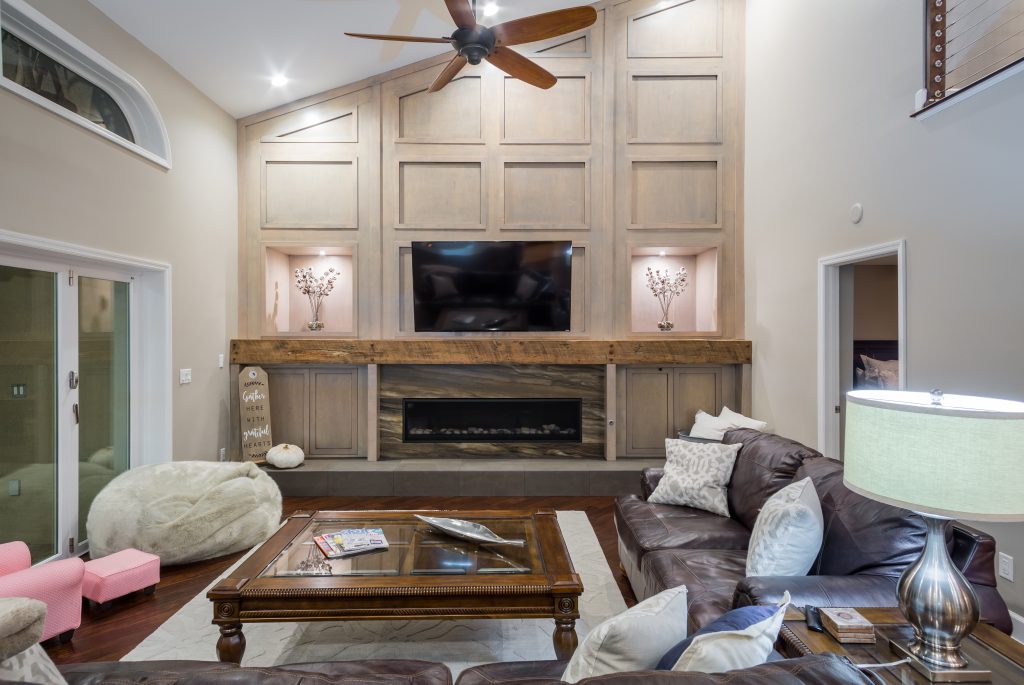Are you a fan of the hearth? Do you love the idea of curling up next to a fireplace with your family, telling stories or playing games? Or perhaps a quiet evening warming your toes, watching the sun set? The idea of a fireplace in a sub-tropical climate may seem contradictory, but it’s very common to see both wood-burning and gas fireplaces in Florida homes. But how do you get started? What if you have an existing fireplace that doesn’t fit your style? Read on for some design and construction advice on installing the right fireplace for your home.
Gas Fireplaces
It used to be very cost-prohibitive to retro-fit a fireplace in a home, requiring the construction of an exterior stone chimney, flue, firebox, and fortification under the floor (such as a new foundation) to hold its weight. Fortunately for homeowners, the evolution of gas fireplaces has made it far easier and more affordable to install a fireplace even if one does not already exist in your home.
There are three ways gas fireplaces can be vented:
- A natural vent uses a masonry/stone chimney or a metal flue to carry fumes from your home. If you don’t have a stone chimney already existing in your home, a natural vent can be created by cutting a hole in the ceiling for a metal flue.
- A direct vent uses a dual venting system that brings in outdoor air and then releases it after combustion. This cuts down on heat loss. One caveat, however: a direct-vent unit must have a sealed glass door for optimum combustion and to ensure indoor air quality.
- A vent-free unit does not require a chimney or any venting at all. This is a slightly controversial unit, due to concerns about carbon monoxide pollution in the home, but due to recent advances, it is gaining more and more popularity as a safe fireplace unit. It uses a technology similar to exhaust systems on new cars sold in the United States to clean hot air as it leaves the combustion chamber.
Each of the above options makes it very simple to select the right gas fireplace for your home. Once you select the unit, it is best to work it backwards and complete all the planning design from there. Get all the parts and pieces worked out before the work begins; otherwise you will spend a lot of unnecessary time and money going backwards to re-do things. As in all things construction-related, completed planning is the keystone to any successful project.
Wood Burning Fireplaces
There is nothing quite like the authenticity of a wood-burning fireplace. While it is easiest to incorporate a wood-burning fireplace into new home construction, there are those homeowners who opt for retro-fitting a fireplace and they’re willing to invest in a renovation to install a true, wood-burning unit.
Just like a gas fireplace, you must have a licensed contractor install a wood-burning fireplace. A permit must be pulled to make sure the unit meets Florida Building Code; masonry, framing, roofing and drywall will have to be done, and possibly even electrical if you want to add strategic lighting over the fireplace. While it is possible to pull a homeowner-builder permit to do the work, you will have to know building code in order to get it approved by your municipality and ensure it safely and properly installed. The best thing to do is hire a licensed professional. You will save yourself a lot of time and money in the long run.

This wood-burning fireplace was fully restored as part of a historic home restoration project we did last year.
Wood-burning fireplaces also come in many different shapes and sizes. Cladding can be done in stone, stacked stone, brick, marble or tile. You can choose to expose your chimney or cover it in drywall, taper it or let it go straight up, create a large hearth or leave it flush with the floor, add a mantel or a mirror above the firebox… the design combinations are limitless.
Here are a few different fireplace designs popular among authentic flame-loving homeowners:
- Traditional Fireplace. Typically open to the home, a traditional wood-burning fireplace is made with exposed masonry, usually brick or stone. It is not a very superior heating system, as it can suck up to 300 cubic feet of heated room air per minute for combustion, only to send it back out of the chimney. The installation of an air-tight fireplace insert makes the world of difference in heat efficiency, so this is highly recommended if you are building a traditional fireplace.
- Clean-Burning Wood Stove. This is the most efficient way to heat a home, as combustion occurs when the doors are tightly closed.
- Rumford Fireplace. Count Rumford, a British loyalist during the American Revolution, spent a great deal of time studying workable fireboxes in both the colonies and England, which led to the creation of his popular design in the late eighteenth century. The Rumford firebox is smaller and shallower than most fireplaces, but the sides are angled, for an unprecedented capacity for heat radiation. Additionally, he streamlined the throat by rounding it, so as to remove any hindrances that might prevent smoke from flowing smoothly up the chimney. Small but mighty, a Rumford will surprise you at its ability to radiate heat throughout a large space.
Summary
According to the National Association of Home Builders, a fireplace ranks a close second to outdoor patios, decks and porches when it comes to home amenities. When deciding on the best fireplace for your home, be sure to get all your planning and design done first, designing everything around the fireplace you select, in order to save yourself from going backwards and re-doing things. Consider size, location (ideally somewhere central in the home), venting, cost, installation procedure and design. Be sure to speak with a licensed professional when doing all your planning; and even better, hire a qualified Design-Build company that can take care of every aspect of the project from design to completion.
Nelson Construction and Renovations, a family business founded in 2006, is a design-build company that specializes in high-end remodels, home additions, and custom homes. With our headquarters in Clearwater, Florida, we serve homeowners all over Pinellas and Hillsborough Counties. We are an award-winning member of the National Association of the Remodeling Industry and have an A+ rating with the Better Business Bureau.
Creative Commons Attribution: Permission is granted to re-post this article in its entirety with credit to Nelson Construction and a clickable link back to this page.
"Reliable, Licensed & Insured Building Contractor"
For A NO Obligation Design Consultation
Contact Us



 Loading
Loading 





